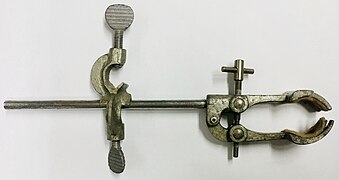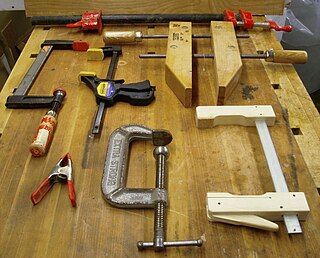
A clamp is a fastening device used to hold or secure objects tightly together to prevent movement or separation through the application of inward pressure. In the United Kingdom the term cramp is often used instead when the tool is for temporary use for positioning components during construction and woodworking; thus a G cramp or a sash clamp but a wheel clamp or a surgical clamp.
The Liebig condenser or straight condenser is a piece of laboratory equipment, specifically a condenser consisting of a straight glass tube surrounded by a water jacket.

Standard diving dress, also known as hard-hat or copper hat equipment, deep sea diving suit or heavy gear, is a type of diving suit that was formerly used for all relatively deep underwater work that required more than breath-hold duration, which included marine salvage, civil engineering, pearl shell diving and other commercial diving work, and similar naval diving applications. Standard diving dress has largely been superseded by lighter and more comfortable equipment.

The dumbbell, a type of free weight, is a piece of equipment used in weight training. It is usually used individually or in pairs, with one in each hand.

A nipple clamp is a type of sex toy that is applied to a person's nipples to pinch them. Varieties of nipple clamp include clothes-pin-style, tweezer and clover. Nipple clamps are used to cause pain in the nipples as part of certain BDSM activities. They are also used to produce erotic stimulation as part of nipple play. In this context they are not primarily used to produce pain but rather to increase nipple sensation. Their use traps blood in the nipples, increasing the sensitivity of the nipple. The sexologist Carol Queen says that "clamps are also very useful for hands-free nipple play".

A vise or vice is a mechanical apparatus used to secure an object to allow work to be performed on it. Vises have two parallel jaws, one fixed and the other movable, threaded in and out by a screw and lever.

A rail integration system is a generic term for a standardized system for attaching accessories to firearms. Rail systems are straight mounting brackets on the gun's receiver, handguard, or fore-end stock to allow sliding or variable-position attachments. An advantage of the multiple rail slots is the moveable positions to adjust for optimal placement of each item for a user's preferences, along with the ability to switch different items at different placements due to varying eye reliefs on gun sights.

Drum hardware is the set of parts of a drum or drum kit that are used to tension, position, and otherwise support the instruments themselves.
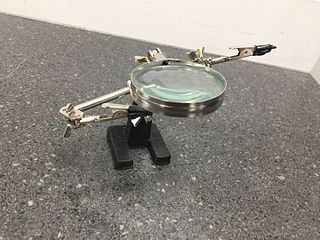
A helping hand, also known as a third hand, soldering hand, or X-tra Hands, is a type of extremely adjustable jig used in soldering and craftwork to hold materials near each other so that the user can work on them.

In chemistry, a retort stand, also called a clamp stand, a ring stand, or a support stand, is a piece of scientific equipment intended to support other pieces of equipment and glassware — for instance, burettes, test tubes and flasks.
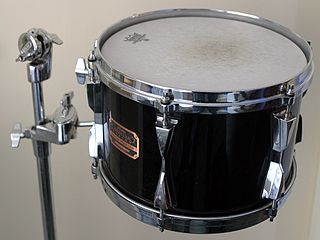
A tom drum is a cylindrical drum with no snares, named from the Anglo-Indian and Sinhala language. It was added to the drum kit in the early part of the 20th century. Most toms range in size between 6 and 20 inches in diameter, though floor toms can go as large as 24 inches (61 cm).

Drafting tools may be used for measurement and layout of drawings, or to improve the consistency and speed of creation of standard drawing elements. Tools such as pens and pencils mark the drawing medium. Other tools such as straight edges, assist the operator in drawing straight lines, or assist the operator in drawing complicated shapes repeatedly. Various scales and the protractor are used to measure the lengths of lines and angles, allowing accurate scale drawing to be carried out. The compass is used to draw arcs and circles. A drawing board was used to hold the drawing media in place; later boards included drafting machines that sped the layout of straight lines and angles. Tools such as templates and lettering guides assisted in the drawing of repetitive elements such as circles, ellipses, schematic symbols and text. Other auxiliary tools were used for special drawing purposes or for functions related to the preparation and revision of drawings. The tools used for manual technical drawing have been displaced by the advent of computer-aided drawing, drafting and design (CADD).
Stage lighting accessories are components manufactured for conventional (non-automated) stage lighting instruments. Most conventional fixtures are designed to accept a number of different accessories designed to assist in the modification of the output. These accessories are intended to either provide relatively common functionality not originally provided in a fixture, or to extend the versatility of a lighting instrument by introducing features. Other accessories have been designed to overcome limitations or difficulties some fixtures present in specific applications.

A tripod head is the part of a tripod system that attaches the supported device to the tripod legs, and allows the orientation of the device to be manipulated or locked down. Modular or stand-alone tripod heads can be used on a wide range of tripods, allowing the user to choose which type of head best suits their needs. Integrated heads are built directly onto the tripod legs, reducing the cost of the tripod system.

An iron ring or ring clamp is an item of laboratory equipment which comprises a conjoined metal ring and radially-extending rod. In some cases, the rod terminates in a screw clamp for attachment to a retort stand or other support; in others, the rod may be attached to a stand by means of a laboratory clamp holder. Iron rings are commonly used in chemistry laboratories for supporting apparatus above the work surface, for example:

A utility clamp is a laboratory apparatus resembling a pair of scissors. The screw in the middle works as the wide adjustment of 2-prong. It is composed of 3 parts: 2-prong adjust, metal rod, and clamp down. This apparatus is connected to a ring stand or retort stand. It is used to hold round laboratory glassware, such as beakers, and flasks, etc. This type of clamp is made from stainless steel.
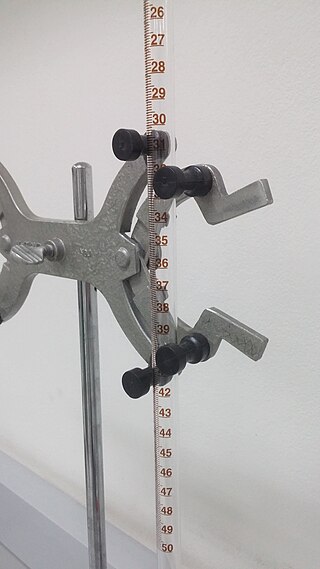
Burette clamp is a scientific equipment which used specifically to hold and secure a burette on a stand, so that a burette is fixed and more convenient for the experiment. Burette clamps can be made with many materials such as plastic and cast iron. However, an iron clamp with a rubber knob to hold the burette are usually more durable. Usually burette clamps come in doubles, which means they can hold two burettes.
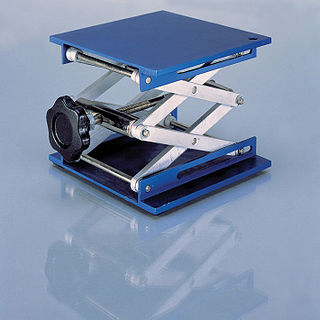
Laboratory scissor jacks are lifting stages for beakers, flasks, water baths, stirrer, or other lab tools used to elevate equipment height to the user's needs, usually around 5 to 20 cm. It consists of metal pieces connected together in a scissor-like shape between a top and a bottom platform. The metal pieces acting as an adjustable lift using the scissors mechanism in changing its height and also can withstand a wide range of weight.

Laboratory drying rack is a pegboard for hanging and draining glassware in a laboratory. It is available in different varieties and sizes. It can be used for different materials of glassware in the laboratory room such as funnels, pipettes, mixing balls, slides, bottle stoppers, tubing and so on. In addition to that, the pegs on the drying rack are easily removable and replaceable in order to maintain the cleaning of the lab racks to avoid contamination with other apparatus used on the same rack. Any common laboratory needs to have at least two or three drying racks per lab.



